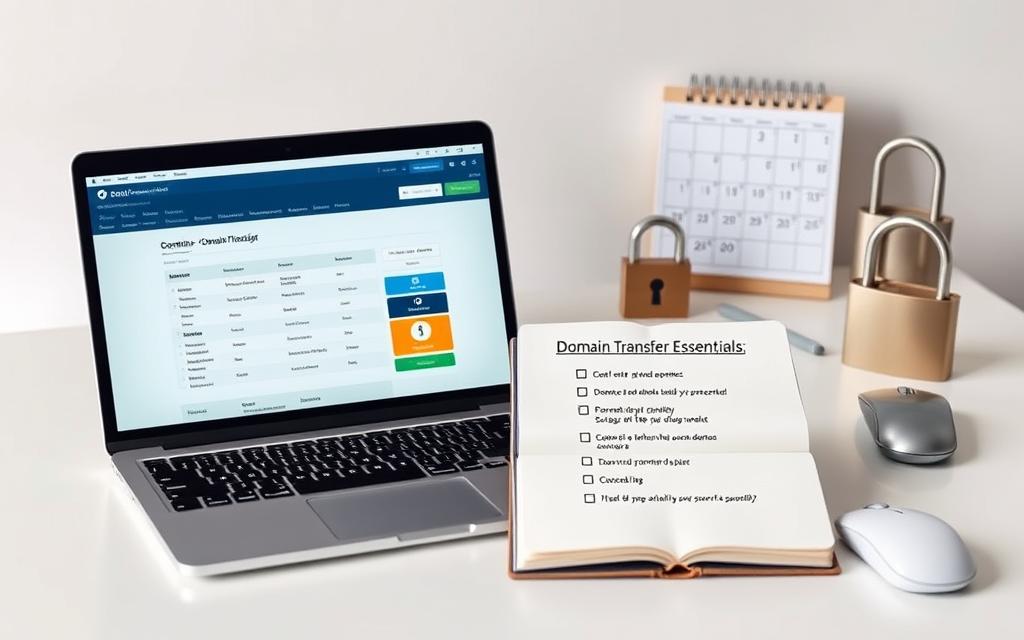Transferring a domain name might seem hard, but knowing a few key steps can make it easier. The process involves moving your domain to a new registrar. This is important to keep your online presence strong. A smooth transfer keeps your site running without any hiccups.
By using a reliable checklist, you can handle each step well. This way, you’re ready for anything that comes up.
Key Takeaways
- Understanding the domain transfer process is key for website owners.
- Have a checklist to make the process smoother.
- A smooth transition keeps your site working well.
- Update your info before starting the transfer.
- Know your options for registrars to find the best one.
- Confirm your transfer to avoid delays.
Understanding Domain Transfers

A domain transfer is when you move your domain name to a new registrar. People often wonder, what is a domain transfer? It’s about switching your domain to another registrar, following ICANN rules. You need to have your domain registered for at least 60 days first. Also, make sure your domain is unlocked for a smooth transfer.
What is a Domain Transfer?
Simply put, a domain transfer moves your domain from one registrar to another. You’ll need an authorization code to prove you own the domain. Knowing why transfer your domain helps decide if it’s right for you. You might want to switch if your current registrar is too expensive or if you want to manage all your domains in one place.
Why Transfer Your Domain?
There are many reasons to transfer your domain. Some include:
- Switching to save money with better pricing.
- Finding a registrar with better customer service.
- Getting services like web hosting or professional email.
- Using tools that make managing your online presence easier.
Experts say to check if your domain can be transferred, know the costs, and be ready for any delays.
| Criteria | Details |
|---|---|
| Minimum Registration Period | 60 days with current registrar |
| Domain Status | Must be unlocked |
| Authorization Code | Required for verification |
| Transfer Timeframe | Typically a few days |
| Potential Issues | Locked domains, privacy settings, contact validation emails |
Preparing for a Domain Transfer

Getting ready for a domain transfer is key to a smooth process. Knowing the domain transfer essentials helps you move forward easily. First, make sure your domain meets all the requirements. Then, collect important details for a successful change.
Check Domain Eligibility
Before you start, check if your domain can be transferred. It must have been registered for at least 60 days. Also, make sure it’s not locked, there are no disputes, and payment is up to date. These steps are critical and are part of the domain transfer guidelines.
Gather Necessary Information
Collecting the right info is another important step. You’ll need:
- Current registrar details
- Account login credentials
- Registration period information
- Email settings and associated accounts
Having this info ready helps avoid problems and makes the transfer smoother. Make sure your contact details are current in the WHOIS database. These domain transfer tips will make your transition easier.
| Domain Eligibility Criteria | Description |
|---|---|
| Domain Age | Must be registered for at least 60 days |
| Status | Not locked or involved in disputes |
| Payment Status | Must be paid current with no outstanding fees |
| WHOIS Accuracy | Contact information must be correct and up-to-date |
By checking these points, you follow the domain transfer guidelines well. Being proactive in gathering info and checking eligibility saves you time and effort later.
Choosing the Right Registrar
Choosing the right domain registrar is key to a smooth domain transfer. You need to look at several things before deciding. It’s important to compare different registrars to find the best one for you.
Compare Domain Registrar Features
Look at the prices, security, and extra services offered by each registrar. Here’s a comparison of some popular ones:
| Registrar | Registration Cost | Renewal Cost | Privacy Protection |
|---|---|---|---|
| Hostinger | $4.99 (2+ years) | $15.99/year | Free WHOIS privacy |
| Domain.com | $11.99 (1+ years) | $21.99/year | $8.99/year (extra) |
| Namecheap | $10.28 + $0.18 ICANN fee | $15.88/year + $0.18 ICANN fee | Free lifetime privacy |
| Porkbun | $10.37 | $10.37/year | Free privacy & SSL |
| GoDaddy | $0.01 (1st year 3-year plan) | Undisclosed | Free lifetime WHOIS |
Consider Customer Support
Good customer support is vital for a great registrar experience. Check if the registrar offers 24/7 support and quick help. Also, look for self-help resources.
Choose a registrar with great user reviews and a strong support history. This is very important during a domain transfer. Quick help can solve problems fast.
Initiating the Transfer Process
To start the domain transfer, you need to follow some key steps. First, unlock your domain and get the authorization code for transfer. These actions are needed by all registrars to keep your domain safe.
Unlock Your Domain
The first thing to do is unlock your domain at your current registrar. Most places lock domains by default for security. To unlock, just log in, go to your domain settings, and turn off the lock.
This step is quick but very important for moving forward with the transfer.
Obtain the Authorization Code
Once your domain is unlocked, get the authorization code for transfer, also known as the EPP code. This code helps prevent unauthorized transfers. Most registrars send the code within five days after you ask for it.
Keep an eye on your email for this code. If you miss it, your transfer could be delayed.
Finishing these steps is key for a successful domain transfer. Remember, transferring a domain can take five to seven days. But, things like verification can make it take longer. Always check your contact info with both your old and new registrars to avoid problems.
Completing the Transfer
Completing a domain transfer needs you to stay informed. After starting the transfer, watch the status closely. Transfers usually take five to seven days, but delays can happen.
Knowing the timeline helps ease worries about the transfer.
Monitor the Transfer Status
Use WHOIS lookup or your new registrar’s tools to track the transfer. This confirms if your domain is moving or if problems need fixing. Some registrars take longer due to checks or old info.
Checking often keeps you in the loop about any delays.
Ensure DNS Settings are Correct
Right DNS settings are key during a transfer. Wrong settings can cause your site to go down. After the transfer, make sure all DNS records are right at the new registrar.
This is vital for your site to work without issues. Wrong DNS settings can really mess things up, so double-checking is a must.
Post-Transfer Considerations
After you transfer your domain, there are key steps to keep your online presence running smoothly. Updating your WHOIS information is essential. It keeps your contact details current, helping you stay in touch with domain authorities and customers. It also protects your domain from unauthorized changes.
It’s also important to check your domain renewal settings with your new registrar. This helps prevent your domain from expiring. A big 75% of domain owners update their contact info before a transfer. You should keep this up after the transfer too.
Update Your WHOIS Information
Updating your WHOIS information is a must. It ensures your contact details are up-to-date. This is key to keeping your domain safe from problems caused by old info. A big 75% of domain owners update their info before a transfer. You should keep this up after the transfer too.
Review Domain Renewal Preferences
Domain renewal settings are critical to keep your site online. Reviewing them can show you options like automatic renewals and special rates. Using these can save you money and keep your site running without interruption. This is important because any downtime can hurt your online image.
| Post-Transfer Steps | Importance |
|---|---|
| Update WHOIS information | Maintains accurate contact details |
| Review domain renewal preferences | Avoids lapses in registration |
| Set up automatic renewals | Ensures continuous domain ownership |
| Explore promotional renewal rates | Maximizes cost efficiency |
Common Issues and Troubleshooting
When you’re in the middle of a domain transfer, you might run into problems. Knowing about common issues like transfer delays and denials can help you fix them fast. Domain transfers usually take 3-5 business days. Delays often happen because of outdated info or needing to unlock your domain.
If your domain isn’t unlocked before starting the transfer, it will take longer. This is a big reason for delays.
Addressing Transfer Delays
Dealing with transfer delays? Start by checking your domain settings. Make sure it’s unlocked and your contact info is up to date. Sometimes, just checking these things can fix the problem.
Remember, DNS changes can take up to 48 hours to spread. So, be patient as the transfer goes through.
Handling Denial of Transfer Requests
Getting a denial of transfer requests can be tough. It’s important to know why it happened. First, check if there are any unpaid fees or domain locks.
If it’s because of an unopened verification email, ICANN might suspend your domain. This can happen in 14 days. By tackling these issues, you can make the transfer process smoother.
FAQ
What is a domain transfer?
A domain transfer moves your domain name to a new registrar. It must have been held for 60 days, as ICANN rules require. You need to prepare well to keep your website online.
Why should I consider transferring my domain?
There are many reasons to transfer your domain. You might be unhappy with your current registrar’s prices or services. Or, you might want to switch to a registrar with better features.
How do I check if my domain is eligible for transfer?
To see if your domain can be transferred, check a few things. Make sure it’s been held for 60 days. Also, it can’t be locked or in a dispute. This makes the transfer go smoothly.
What information do I need to gather for a domain transfer?
You’ll need some important details for the transfer. Get your login info, domain registrar details, and email settings. Also, make sure your WHOIS database info is up to date.
How can I choose the right registrar for my domain transfer?
When picking a registrar, compare a few things. Look at prices, security, extra services, and customer support. Make sure they’re ICANN accredited and read customer reviews.
What is the first step to initiate the domain transfer?
The first step is to unlock your domain. This stops unauthorized transfers. You’ll also need an authorization code to protect your domain during the transfer.
How long does a domain transfer take?
Domain transfers can take 5 to 7 days, depending on the registrar. Keep an eye on the status to ensure a smooth transfer.
What should I do after the domain transfer is complete?
After the transfer, update your WHOIS info with your current details. Also, check your domain renewal settings. Setting up automatic renewals helps keep your domain registered without hassle.
What common issues might I face during a domain transfer?
Common problems include delays due to outdated info or a locked domain. If your transfer is denied, check your ownership and any fees with your current registrar.




